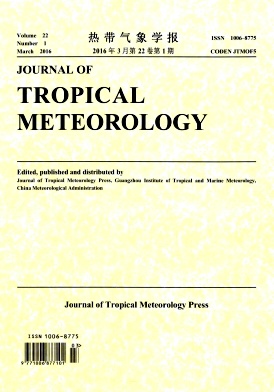|
[1]
|
WEHNER M. Predicted twenty-first-century changes in seasonal extreme precipitation events in the parallel climate model [J]. J Climate, 2004,17(21): 4 281-4 290. |
|
[2]
|
GROISMAN P Y, KARL T R, EASTERLING D. Changes in the probability of heavy precipitation: Important indicators of climatic change [J]. Climate Change, 1999, 42(1): 243-283. |
|
[3]
|
JIANG Tong, SUN Bu-da, WANG Yan-jun. Trends of Temperature, Precipitation and Runoff in the Yangtze River Basin from 1961 to 2000. Advances in climate change research [J]. 2005, 1(2): 65-68. |
|
[4]
|
ZENG Xiao-fan, SU Bu-da, JIANG Tong, et al. Projection of future climate change in the Yangtze River Basin for 2001-2050 [J]. Adv Climate Change Res, 2007, 3(5): 293-298. |
|
[5]
|
LIU Lv-liu, LIU Zhao-fei, XU Zong-xue. Trends of climate change for the upper-middle reaches of the Yellow River in the 21st Century [J]. Adv Climate Change Res, 2008, 4(3): 167-172. |
|
[6]
|
KANG Li-li, WANG Shou-rong, GU Jun-qiang. The simulation test of the distributed hydrological model DHSVM on the runoff change of Lanjiang River basin [J] J Trop Meteorol, 2008, 24(2): 176-181. |
|
[7]
|
XU Y, Xu C, GAO X, et al. Projected changes in temperature and precipitation extremes over the Yangtze River Basin of China in the 21st century [J]. Quatern Int, 2009, 208 (1): 44-52. |
|
[8]
|
SHI Y, GAO X, ZHANG D, et al. Climate change over the Yarlung Zangbo -Brahmaputra River Basin in the 21st century as simulated by a high resolution regional climate model [J]. Quatern Int, 2011, 244: 159-168. |
|
[9]
|
DU Yao-dong, SONG Li-li, MAO Hui-qing, et al. Climate warming in Guangdong province and its influences on agriculture and the adaptation measures [J]. J Trop Meteorol, 2004, 20(3): 302-310. |
|
[10]
|
FENG Yan, YANG Xiao-ling. Preliminary study on the general plan for the ecological construction project in the Zhujiang River valley [J]. Forest Res Manage, 2004, 20(3): 302-310. |
|
[11]
|
LIU Bing-jun, CHEN Xiao-hong, ZENG Zhao-fa. Spatial distribution law of rainfall in the lower reaches of the pearl river basin [J]. J Nat Res, 2010, 25(12): 2 123-2 131. |
|
[12]
|
LIU Yan-qun, CHEN Chuang-mai, ZHENG Yong. The characteristics of spatial distribution and types of Apr-Sept rainfall in the river basin [J]. J Trop Meteorol, 2008, 24(1): 67-73. |
|
[13]
|
LU Hong, CHEN Si-rong, GUO Yuan, et al. Spatial-temporal variation characteristics of extremely heavy precipitation frequency over south China in the last years [J]. J Trop Meteorol, 2012, 28(2): 219-227. |
|
[14]
|
PENG Jun-tai, ZHANG Qiang, CHEN Xiao-hong, et al. Spatial and temporal evolution characteristics of extreme rainfalls in the Pearl River Basin [J]. J Catastroph, 2011, 26(4): 24-28. |
|
[15]
|
HUANG Xiao-yin, TAN Hao-bo, LI Fei, et al. Changes of flood-season severe precipitation over South China in the 21st century [J]. Meteorol Sci Technol, 2009, 37(4): 425-428. |
|
[16]
|
HUANG Xiao-yin, WEN Zhi-ping, DU Yao-dong, et al. Scenario analyses on the changes of future surface air temperature and precipitation south China [J]. J Trop Meteorol, 2008, 24(3): 254-258. |
|
[17]
|
LIU Lv-liu, JIANG Tong, XU Jin-ge, et al. Responses of hydrological processes to the climate change in the Zhujiang River Basin in the 21st Century [J]. Adv Climate Change Research, 2012, 8(1): 28~34. |
|
[18]
|
LIU Lv-liu, DAN Tong, YUAN Feng. Observed (1961-2007) and projected (2011-2060) climate change in the Pearl River Basin [J]. Adv Climate Change Res, 2009, 5(4): 209-214. |
|
[19]
|
MOSS R, EDMONDS J, HIBBARD K, A E. The next generation of scenarios for climate change research and assessment [J]. Nature, 2009, 463(7282): 747-756. |
|
[20]
|
WANG Shao-wu, ZHAO Jun-ci, LUO Yong, et al. Observed (1961-2007) and projected (2011-2060) climate change in the Pearl River Basin [J]. Adv Climate Change Res, 2012, 8(4): 305-307. |
|
[21]
|
XU H C, XU Y. The projection of temperature and precipitation over China under RCP scenarios using a CMIP5 multi-model ensemble [J]. Atmos Ocean Sci Lett, 2012, 5(6): 527-533. |
|
[22]
|
XU H C, XU Y. Preliminary assessment of simulations of climate changes over China by CMIP5 multi-models [J]. Atmos Ocean Sci Lett, 2012, 5(6): 489-494. |
|
[23]
|
JI Zheng-ming. Climate change in China as simulated by a high resolution regional climate model under new emission scenarios [R]. Institute of Tibetan Plateau Research, Chinese Academy of Sciences , 2012 |
|
[24]
|
PAL J S, GIORGI F, BI X. The ICTP RegCM3 and RegCNET: Regional climate modeling for the developing world [J]. Bull Amer Meteorol Soc, 2007, 9(88): 1 395-1 409. |
|
[25]
|
AMMANN C M, MEEHL G A, WASHINGTON W M, et al., A monthly and latitudinally varying volcanic forcing dataset in simulations of 20th century climate [J]. Geophys Res Lett, 2003, 30(12): 87-104. |
|
[26]
|
XIE P, YATAGAI A, CHEN M, et al. A gauge-based analysis of daily precipitation over East Asia [J]. J Hydrometeorol, 2007, 8(3): 607-626. |
|
[27]
|
XIE Zhi-qing, JIANG Ai-jun, DING Yu-guo. Spatial-temproal features of annual extremes of heavy precipitation processes in the Yangtze River Delta [J]. J Nanjing Inst Meteorol, 2005, 28(2): 267-274. |
|
[28]
|
WEI Feng, DING Yu-guo, BAI Hu-zhi. Simulation tests of temporal spatial distributions of precipitation extremes over China based on probability weighted moments estimation [J]. Adv Earth Sci, 2005, 20: 65-70. |
|
[29]
|
ZHAI Pan-mao, REN Fu-ming. Detection of trends in China's precipitation extremes [J]. J Meteorol Res, 1999, 2(57): 208-216. |
|
[30]
|
YANG Hong-long. Scenario analyses on future change of extreme climate events over China using PRECIS [D]: Lanzhou university, 2010 |
|
[31]
|
SONG Rui-yan. Projected future changes of extreme precipitation climate events over china by a high resolution regional climate model (RegCM3) [D]: Chinese academy of meteorological sciences, 2008 |
|
[32]
|
BOER G. Climate change and the regulation of the surface moisture and energy budgets [J]. Clim Dyn, 1993, 8(5): 225-239. |

















 粤公网安备 4401069904700002号
粤公网安备 4401069904700002号
 DownLoad:
DownLoad: